They were told—by no less than Harry Reid, in fact—that their contributions would last forever. It was 1998, and they were only 10 or 11 years old, though, so the concept of immortality was a little bit foreign. They knew all the adults were pretty excited, that they and the classmates who had helped them out had gotten out of school for a party, a pep talk, a really good lunch and an orange T-shirt that read “Airport Design Team.”
Reid was talking about the little drawings they’d made a year and a half earlier for a contest their art teachers made them enter. They would be included in a massive tile mural—7,776 8-inch-square tiles in all. Millions of people, they were informed, would step on or off the trams at the D Gate of McCarran Airport and see pictures of the great cities of the world as rendered by fourth-graders across Las Vegas. Beneath them, for those travelers with the time to care, would be their names in black bold type against the gray ceramic wall.
I remember it as the nicest, purest, least cynical part of the entire endeavor. Eleven years ago, I was the Review-Journal’s county government reporter as the D Gate section of McCarran Airport prepared to open. It cost $200 million—excess symbolized in my piece in the R-J by the fact that those fake palm trees alone cost $114,000 apiece—and, while it was undeniably pretty, it was also mired in a political corruption probe involving lucrative airport concessions contracts.
A few days prior to the terminal’s opening, I toured the D Gate to do an architectural piece for the R-J, and I saw them: A large group of children in those orange shirts being celebrated by the 16 colorful 12-by-18-foot murals near the tram. For whatever reason, I did not include them in that story, but the sweetness of that image never left my mind as years and countless flights in and out of McCarran passed.
Every time I flew out of the D Gate, I would wonder: What became of those kids? The adults had, for once, told the truth: Their work would endure, their names would be glanced at daily, they were, in fact, members of an exclusive little club. Did any of them stop by every so often to take a look? Were any of them artists?
As it happened, it was relatively easy to find many of these Millennials thanks to Facebook and Google. I located 11 of the 18 artists, and in seven cases I was able to interview them. (Some were either indisposed, told me to call but then never called back or just didn’t respond.)
What emerged from those lucky seven conversations was a snapshot of a generation. Some keep in touch; others don’t. Some had their lives shaped by the experience; others had never even been back to look at it.
DANIELLE MCADORY
Mural city: Las Vegas
“Try not to do Vegas unless you have to,” Danielle McAdory’s art teacher warned her students at Robert E. Lake Elementary School. “Everyone else is going to do Vegas. You’ll have a better chance if you do another city.”
Danielle decided to defy the odds anyway and take a shot. She’d gone to the library for books on other cities, but other kids had taken them out, so she forced her mom to drive her to the supermarket late the evening before the drawing was due. There they bought Vegas postcards, and, by morning, she had submitted a mash-up of images that included the Excalibur, Luxor, Stratosphere, MGM Grand and New York-New York.
“New York-New York was still being built, so I think I put in the hand with the torch,” said McAdory, 22, who graduated from Cheyenne High, moved to Houston for an eight-year pharmacy program at Texas Southern University and now lives with her boyfriend and their 2-month-old son.
This being the hometown airport’s mural, some casino politics did come into play. Her original drawing featured the MGM Grand’s original lion entrance, which, by 1998, had been replaced with the golden statue, so it was altered, Also, an awkwardly placed pirate ship meant to represent the Treasure Island was added in front of the Excalibur’s drawbridge.
McAdory never fancied herself an artist, although she did go on to teach dance classes to children and adults through a school district program when she was just 15.
“I didn’t realize until we started putting together the mural itself what a big deal this was,” she said. “Honestly, I forget about it most of the time. If someone mentions that they’re going to the airport, then I might tell them.”
MARYBETH ACAC
Mural city: San Francisco
“After the mural came out,” Rancho High graduate Marybeth Acac, 22, said, “people started realizing I had some kind of talent, and they kept telling me I should use it. But it was dormant for a while. I used the skill for student government campaigns, but that was all.”
Then, in the grueling early going of her undergraduate life at Georgetown University, Acac picked up an elective drawing class and “realized I really loved it.”
Her studio art minor would come in handy as a radical departure from the heavy lifting of her actual major, theology and religious studies. She’s now just begun a graduate program at Georgetown in Islam and Muslim-Christian relations, but her apartment is full of her paints and paintings.
The original drawing of San Francisco that she did at Daniel Goldfarb Elementary, however, still resides at her family home in Las Vegas. She chose that city because her cousins lived there, and the summer before her fourth-grade year, her sister got to visit them without Marybeth. “I remember being really jealous,” she recalled.
She included all the highlights—the Golden Gate Bridge, cable cars and Fisherman’s Wharf—and she won despite the fact that she misspelled the city’s name in the original. (It was corrected.)
“All in all, the San Francisco mural stands as a forerunner to my current passion for the arts, an innate part of me that somehow found a way to restore itself,” she said. “At least now I know how to spell San Francisco.”
SAMANTHA STEELMAN
Mural city: Chicago
A rabbi traveling through McCarran some years ago spotted Samantha Steelman’s name on the wall beneath the mural of Chicago. The following Shabbat, he sought out the 11-year-old child to ask her about it. Young Samantha had, at that point, largely given up art, so traumatized was she by her mother’s recent diagnosis of sarcoidosis, the lung disease that became better known in 2008 when it felled comic Bernie Mac.
The rabbi’s discovery “brought me back to art,” said Steelman, now 22 and a UNLV senior double majoring in art and political science while caring for her now-single mother, who also is battling cancer. “He recommended that I do some stuff for the Jewish Community Center, and I never stopped again after that.”
Indeed, having her picture chosen for the D Gate was “one of my fondest memories.” Everything about the experience is so etched in her mind that, when she returned to look at the mural for a Weekly photo shoot, her eye went right to a place where the tile factory failed to apply the correct color to the bangs of a child in the drawing’s bus.
“I had won art contests before this one, but this was the first one where I got the recognition for it and I thought, ‘Wow, maybe I can do this, maybe I can draw,’” said the graduate of the Las Vegas Academy of International Studies, Performing and Visual Arts, the Clark County School District’s highly selective magnet high school.
Intriguingly, the triumph also awakened her to politics, the other half of her UNLV double major. Sen. Harry Reid’s address to the students at that airport celebration sparked an interest, and she was impressed when he remembered her from that crowd during her week in Washington, D.C. (She and Marybeth Acac both happened to be the two Nevada 17-year-olds chosen in 2004 to attend Girls Nation, a weeklong high school summer program in Washington, D.C., organized by the American Legion Auxiliary to teach students about government.) She interned for two years in his Las Vegas field office during college.
Still, Steelman, who graduates in December, hopes to make a career of art, perhaps as an art director for a publication or film, she said. She admits, though, that she’s daunted by the challenge of living up to the success she had as a tot.
“I even thought when it first happened, ‘Wow, I’m in the fourth grade. What can I do to top this?’” she said. “But then it’s really special, sort of surreal. How many people look at it every single day? It’s something I can bring my kids and grandkids to and be able to say I did this when I was your age. Not many people have something like that.”
JERI HENDRICKS MELINKOVICH
Mural city: London
The strange thing about it, as Jeri Hendricks Melinkovich looks back on it, was that fourth grade was a pretty good year for her. She won the art contest that would turn her rendering of London into a massive, permanent display in the airport, and she even starred in a version of The Sound of Music at C.T. Sewell Elementary.
Strange, that is, because it was also the year her older sister was diagnosed with an extremely rare liver cancer and died after months of grueling treatments in a Salt Lake City hospital that drew her parents away for lengthy stretches.
When it was all over, Jeri’s mom Bobbi was grateful for all the distractions provided to her youngest child. “I actually remember writing a letter to the architects to tell them what a good diversion it was for us and our family,” Bobbi said. “We had been so wrapped up in that for a long time. It was such a nice thing.”
It’s not entirely surprising, then, that Jeri Hendricks grew up quicker than most. The Foothills High graduate is now a 22-year-old University of Wyoming law student who has been married for three years, has completed a triathlon and has a 10-month-old daughter, Roxanne. Jeri finds time somehow to even faithfully document Roxanne’s life on a blog, too.
One thing she’s not done: visited London. In fact, she copied some images from a book for her mural, but she doesn’t know that much about the British capital. “It’s definitely a place I’d like to go some day,” she said. “I know I included Big Ben, the double-decker buses and, I don’t know what they call those guards with funny hats.” After the picture was selected, she enlarged the bus for the blown-up version so she could include some people, which is how her Sewell principal, a Mr. Nomba, ended up as the driver.
“It probably inspired her to always do her best, to try, to not be afraid, to participate,” her mother said. “She’s one of those go-getters.”
Jeri’s sister, Hayley, has also been immortalized; in 2001, a park in Henderson was named for the late Hayley Hendricks, former Brown Junior High president and a close friend of then-Mayor Jim Gibson’s daughter. That leaves Jeri and Hayley’s other sister feeling slightly neglected. Wrote Jessica Hendricks in a bemused e-mail: “I have yet to make my mark, but I’ve always thought I should try to get a building named after me or something so I can attempt to keep up with my awesome siblings!”
STEPHEN PICKERING
Mural city: Washington, D.C.
You look at the pictures, read the Facebook page and come to a pretty reasonable conclusion.
“Hey, am I catching you at a frat house?” I asked Stephen Pickering, a 22-year-old University of Nevada Reno senior and Palo Verde High graduate.
“Uh, yeah, you are,” he answered with a bit of surprise.
Didn’t take Sherlock. He was an adorable little blond boy in the photos his mother had provided of him with his mural of Washington, D.C., and he grew up to be a lean hottie who posts pictures online of himself shirtless and of his extremely fine girlfriend. Oh, and here are some of the Facebook groups to which he belongs: The College Beer Pong Championship, Reno Beer Crawl and SHIT on SAE Pledges for Scrubs. Sigma Alpha Epsilon is said fraternity.
It also might not be a surprise that Pickering’s life has been relatively unaffected by winning the McCarran contest. Unlike his classmate at Lummis Elementary, Samantha Steelman, who planned her picture carefully and spent many hours working on it, Pickering did it because a teacher suggested he give it a go. She even suggested Washington, D.C., so he browsed some books, pulled out his markers and voila.
“I put the Lincoln Monument, the Capitol building, the White House and I put the big tall pointy one, I forget what that was called,” Pickering said. He’s still never visited D.C.
This is not to say it wasn’t a thrill. His family went on a cruise one time from Miami, and when they were at the airport, “we kind of sat there and took a look at it.” And even though he never wanted to be an artist—he’s getting a finance degree and plans to move back to Vegas to work for Merrill Lynch—winning the contest “was absolutely exciting.”
“I didn’t know how big a deal it was when I was drawing it, and then I come to find out I end up winning it,” he recalled. “Then we went to this whole banquet thing where they were telling us that they were getting them all blown up and screened, and I was like, ‘Holy shit!’”
ALICIA BURNS-WRIGHT
Mural city: Sydney
If there is a valedictorian for this crop, it would have to be Alicia Burns-Wright. The 22-year-old Valley High graduate moved on from Las Vegas to get a sociology degree at Rice before heading to Harvard Law School. This past summer, she interned in the Department of Education’s general counsel’s office.
The contest triumph, she insisted, was a fluke. Her class at Helen Herr Elementary School was told to focus on Sydney, Australia, so Burns-Wright “found some documents to look at about historical Australian art and the skyline, and then I just drew whatever came to mind when I was 9.”
The result is one of the more abstract representations of cities in the McCarran collection, with Aboriginal figurines floating over the Harbor Bridge and Sydney Opera House against a black background despite the sun.
“I don’t think I was ever an artist except that one time, I guess,” she said.
Perhaps, but she’s clearly aware of art. Just two years ago at Rice, she won first place in a national paper competition sponsored by the Association of Black Sociologists and delivered the paper to the group’s conference in New York. The paper was titled “Bratz: Friend or Foe to the Movement Toward Racial Equality,” and analyzed the use of racial stereotypes in a Saturday-morning cartoon show.
Even though she’s still never visited Sydney, she feels a connection.
“Every time I meet someone from Australia, I tell them my little story,” she said. “I say, ‘There’s a picture up in the airport,’ and sometimes they’ll say, ‘Oh, I’ve seen it when I’ve been in Vegas.’”
JUSTIN MAFFETT
Mural city: Rio de Janeiro
It might’ve been the one week of his entire childhood when the other kids would have to be nice to him. After all, his was the drawing of Rio de Janeiro that had won the contest, and now his classmates would be indebted to him for getting their names forever inscribed on the airport walls as helpers. But the week the fourth-graders of Lomie Heard Elementary School were coloring in the enlarged version, Justin was out sick. He missed school, missed the coloring, missed even the chance to enjoy that small respite from years of social ostracism. And it didn’t get much better from there.
A loner who turned goth, Maffett experimented with drugs and alcohol while attending Rancho High School and became a full-blown junkie—meth, coke, alcohol, weed, you name it—in his first years at UNLV. His parents kicked him out and tried to force him into rehab, but it took an epiphany while riding a city bus that he “just didn’t want this anymore” to prompt a cold-turkey cessation.
That was two years ago. Since then he’s repaired his relationship with his parents and taken a job with a homeowners association collections agency.
Understandably, then, the triumph of his youth had receded far in the back of Maffett’s world when I called to ask him about it. There’s a framed version of it on a bookshelf in his parents’ home, but otherwise he didn’t think about it much and had never gone to see it since that day of orange shirts and hullabaloo.
“Is that still there?” he asked me.
“It is. Want to go see it?”
And so we met, along with Samantha Steelman of the Chicago drawing, to shoot some photos. As we waited for Samantha, I could tell it wasn’t hard to peer past the pierced lip and the clear gauges in his earlobes to imagine Maffett as the picked-on, timid kind of slight-sized boy who couldn’t even buy a few minutes of grammar-school peace by immortalizing his brethren. There was an earnestness, a sorrow, an awkwardness in the black-clad 22-year-old who is trying his best to pull his life back together after several challenging years.
Things go awry, it seems, despite his best intentions. He met a woman last year, and they got married when she got pregnant with their now-2-month-old son. “We met last September, and we thought we were in love and stuff, so we got married to get her insurance and that kind of stuff.”
On the D Gate concourse, Maffett appeared to have little reaction to beholding and mugging before his mural. But later that evening, he texted me.
“Thanks for getting me back in there to see it,” he wrote.
“Was it weird?”
He took a few minutes to answer.
“It was really nice to see it again. Makes me wonder why I quit painting. Still love photography, though. The other girl made me realize where I could be had I not screwed everything up. But, of course, if it hadn’t played out how it did, I wouldn’t have my son.”
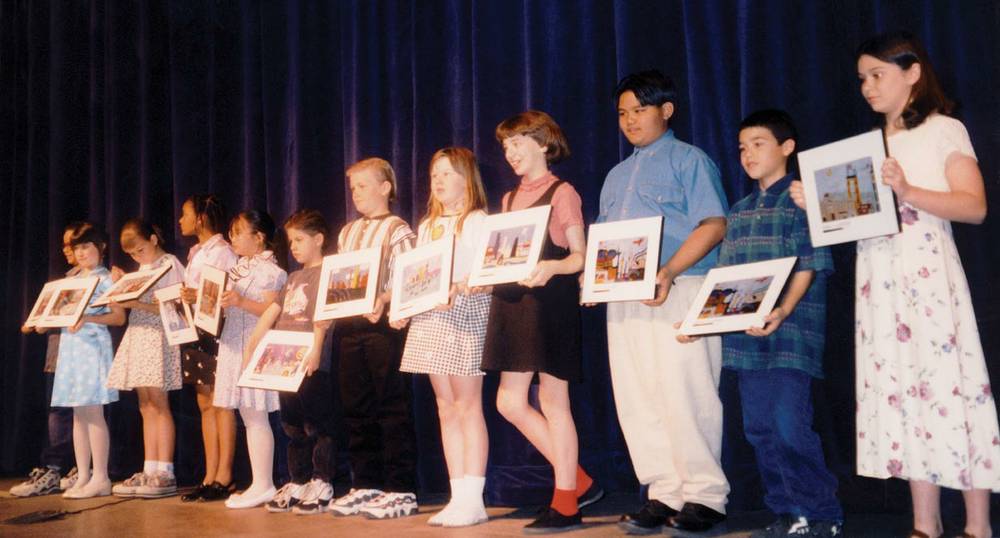
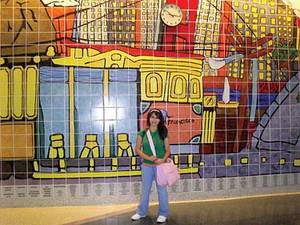
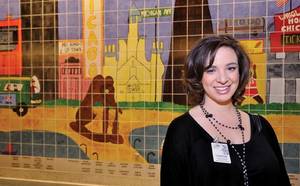
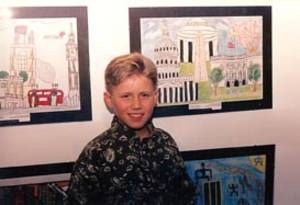
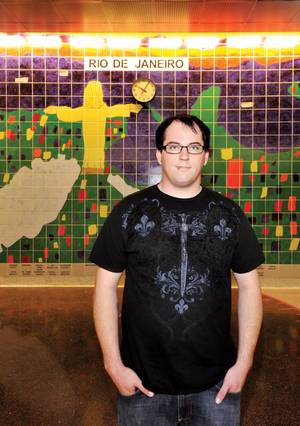

Previous Discussion: